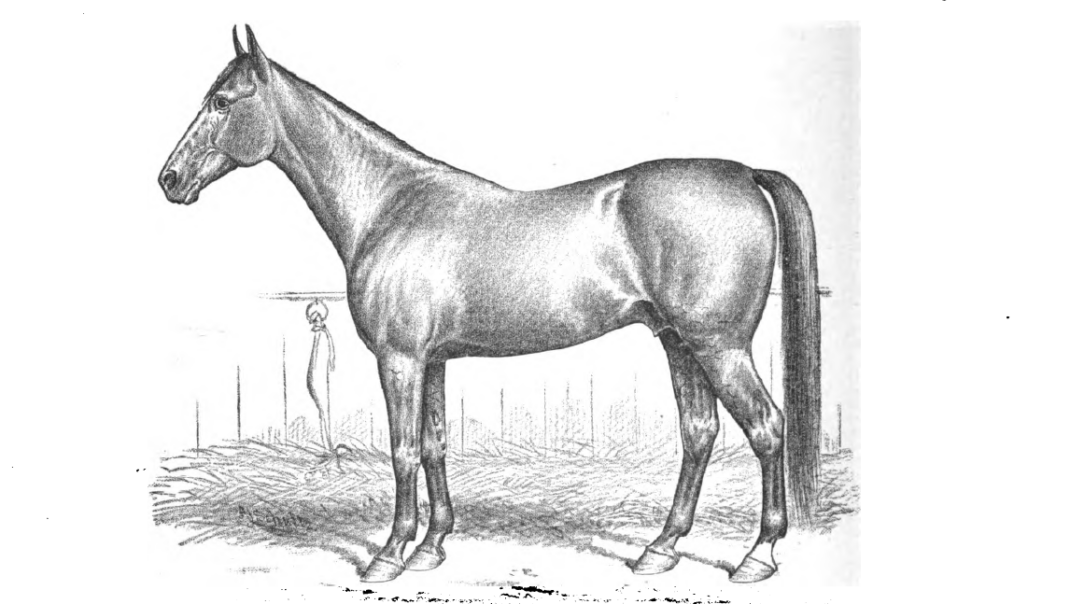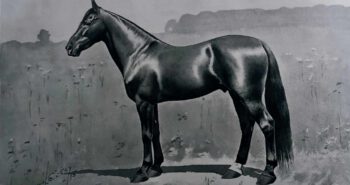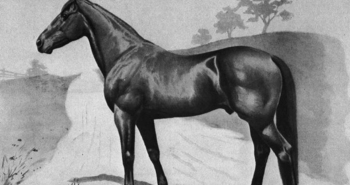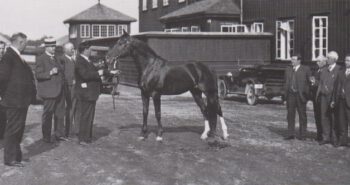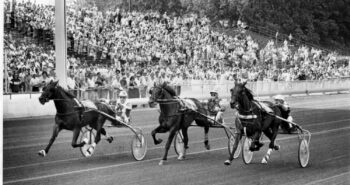One of the first great stallions of the mid-1800s, Mambrino Chief was also the first star stallion in Kentucky and founded one of the first trotting families.
Bred by Richard Eldridge of Mabbettsville in Dutchess County, NY, Mambrino Chief came from familiar blood. He is by Mambrino Paymaster, a son of Mambrino, which means that he shares the paternal grandsire with Hambletonian. His maternal pedigree, however, was quickly lost to history. All that is known is that his dam “was a large and somewhat angular mare of untraced blood.” Some sources state his dam was large and coarse and “from the west”, meaning from Pennsylvania, indicating she might have been part Frisian. This is, however, just speculation.
Some have claimed that Mambrino Chief’s dam, often just referred to as the Edridge Mare, was by the Latham Horse, also known as Morgan Chief, who was a both paternal and maternal grandson of the famous Justin Morgan. However, nothing has been produced to attempt to prove this allegation. In the Breeders and Sportsman of Jun 12, 1886, it was suggested that the Eldridge Mare was sired by Messenger Duroc, a thoroughbred born 1820: “we are so fortunate as to have her described by one, Mr Pepsion Haight, whose brother once was her owner, and whose self was familiar with her during many years: ‘She was about 15 1/2 hands high, of a dark brown color, of heavy mould, body long and deep, and legs sturdy and well set on. She has as good a head, ear, neck, shoulders and legs as I ever saw on a horse. The one fault to be found in her build was as to her loins, which were rather narrow, but the space between her hips was wide, and her quarters were heavy. She was a fast walker, and a great roadster, with speed sufficient to haul a common box wagon, with two men in it, at a three-minute gait.’ Such, in the dim light of the horse world of forty years ago and more, was a rough portrait of Mambrino Chief’s dam, and its interest will be enhanced by one of her supposed sire, Messenger Duroc, through whom the claim of Mambrino partisans, that the paragon possessed a double strain of Messenger blood and a powerful current of that of Diomed is possible to be substantiated.” In the same article, Messenger Duroc’s breeder Ambrose Stevens is quoted as saying that the resemblance of Mambrino Chief to Messenger Duroc was so obvious that if he had been told that the the former was the son of the latter, he would readily have believed that.
What is for sure, though, is that the Edridge Mare, also produced Mambrino Chief’s full-brothers Goliah, who trotted 2:33 in 1851 in Pennsylvania, as well as a horse simply referred to as “the Cox Horse” which, to quote from the Breeder and Sportsman, “although not used for the track, is said to have been the king of New York City’s roadsters about 1851-2.”
Going to Kentucky
A natural trotter, Mambrino Chief was sold to Warren Williams at 3. He passed to GT Williams, who then sold him to James M Cockroft and in the spring of 1851. At that point, there was no systematic breeding of trotters in Kentucky. In The American Trotter, John Hervey credited two men for starting the breeding of trotters in Kentucky: James J Clay and Robert A Alexander. A son of statesman Henry Clay, defeated in three presidential elections, According to Hamilton Busbey in his Recollections of Men and horses, James B Clay visited Thorne in 1853 to inspect cattle and “while there asked for a stallion that would do so cross on well-bred Kentucky mares. Thorne suggested Mambrino Chief, because he liked his strength and his way of going, although his feet were not the best, being subject to quarter crack. Other parties recommended Burr’s Washington, the sire of Lady Washington, and Mr Clay went home in doubt. January 2, 1854, Mr Clay wrote to Mr Thorne to buy Washington at $3,000 if he liked him. Mr Thorne frankly replied that he did not like the horse and then Mr Clay requested him to buy Mambrino Chief at $4,000.” To be on the safe side, Clay sent Josiah Downing to New York. Mr Thorne took the visitor to look at both Burr’s Washington and Biggart’s Rattler. Downing didn’t like either horse, which made Clay make up his mind about Mambrino Chief. Buying Mambrino Chief soon thereafter, Downing then rode the colt the entire way to Kentucky, arriving at Clay’s Ashland farm on February 21, 1854.
Canceled match races
Five days later, Clay wrote to Thorne that “I am happy to advise you that Mambrino Chief arrived on Tuesday, although thin, in fine condition. He surpasses expectations, and twenty mares were engaged to him within an hour. Will limit him to 80 mares at $25.” Though he was bought in part for his trotting abilities, Mambrino Chief hadn’t started in any official races in New York. Busbey wrote that Mambrino Chief had trotted the Washington Hollow track in 2:36 and was timed a quarter in 37 seconds, but it wasn’t an official record. Clay started training his colt, but ended up making money by not racing. On Aug 24, 1854, the Louisville Daily Courier reported that “Mr Wm J Bradley not long since published a challenge, in which he proposed to trot Pilot Jr, against any stallion that had made a season in Kentucky this year, for $1000 a side, $500 forfeit, at either two, three or four mile heats, in harness, the acceptor having the right to name either of those distances, and the race to come off over the Lexington Association Course, on the 12th day of October next. Mr Jas B Clay has accepted the challenge, and has named, as Pilot’s competitor, his stallion Mambrino Chief, selecting two mile heats as the distance. Each of these stallions has a high reputation, and the race will be a spirited affair.”
But it wasn’t going to be a spirited affair – or any affair, for that matter. Mambrino Chief impressed so much in training that the owner of Pilot Jr opted to simply pay forfeit. This was not the only time. Says James B Clay Jr to the Philadelphia Record in 1892: “General Singleton and my father were the very best of friends, and the match which I think was for $10,000 a side, $5,000 forfeit, grew out of a friendly rivalry between the two men. We had a fairly good track at Ashland, and on it Mambrino Chief was trained. I think that the late Dr Herr did some of the training. A short time before the day set for the race General Singleton paid father the forfeit, he believing, no doubt, that Silverheels would be defeated. Father arranged two other matches for Mambrino Chief, one with St Lawrence and the other with Pilot Jr., and in each of these races he also received forfeit money from the owners. The owner of St Lawrence not only paid forfeit, but presented father with a beautiful filly by his horse. The day before the match with Silverheels or Pilot Jr, I forgot which, Mambrino Chief trotted a mile over our track in Ashland in 2:28, and on the day of the match he trotted the Kentucky association running course which, as you know, has a considerable hill, in 2:33.”
The latter information almost sounds to good to be true, given that the absolute world record in 1855 had been set by Flora Temple in 2:27, a mere second faster than Mambrino Chief’s workout at Ashland. Regardless, Mambrino Chief’s legacy was built through a relatively limited stallion career in Kentucky, though he did have a few get back in New York state. As he died relatively early he had considerably fewer crops than his biggest contemporary, Hambletonian, and his best get achieved success after their sire was dead. Moreover, he stood in Kentucky before the Bluegrass state was brimming with great trotting mares. Despite this, Mambrino Chief was an excellent producer of speed.
A dispute over looks
According to some, Mambrino Chief was an extremely coarse horse: “Mambrino Chief 11 was an extremely coarse horse, but his most famous son, the Doctor’s stallion Mambrino Patchen, out of a three quarters (almost) thoroughbred mare, was the handsomest trotting stallion in Kentucky (or America) until the Doctor took over his son, Mambrino King, from Ambrose Young, and made him into The Handsomest horse in the World.” This was echoed by Ken McCarr in The Queen of the Teens in Hoof Beats in Dec 1967: “The Chief was anything but a beauty and he passed his coarse conformation on to most of his foals; however, his achievements as a sire made people forget his lack of beauty.” Not everybody agreed, though. Thorne described Mambrino Chief as “a horse with large head, full of character; a good neck, with excellent shoulder; legs strong and fluted, but with a large foot subject to quarter crack.” Maybe the most precise description was given in The Courier-Journal that, in an article on Nov 26, 1886, underscored hos that the colt was coarse compared to what they were used to in Kentucky: “Mambrino Chief was a large, and to Kentuckians, accustomed to the symmetrical thoroughbred, a coarse horse, but he had courage and trotting action. His descendants today have by the infusion of thoroughbred blood, increased the courage and the speed and eliminated the coarseness.”
According to an article on Mambrino Chief in the Kentucky daily The Blue-Grass Clipper on Jun 12, 1884, “being a grandson of Messenger, he inherited his power of transmitting speed and the trotting gait in the direct line, and considering the early day at which he appeared, and the limited opportunities enjoyed by him, his success as a sire of trotters can hardly be overestimated in the 2:30 list.” Already in 1856 he produced Maid of Ashland, later renamed Lady Thorn. She was one of the best trotters in the US in the late 1860 until an accident in August 1870 forced her into retirement. Lady Thorn drew lots of attention to her sire who, however, by then was already long dead. With the Civil War approaching, the secessionist Clay reduced his livestock holdings. In 1857, he sold Mambrino Chief at his stock auction for $5,025 to Willis Jones of the nearby Woodford County. Mambrino Chief died there on Mar 28, 1862.
A great producer
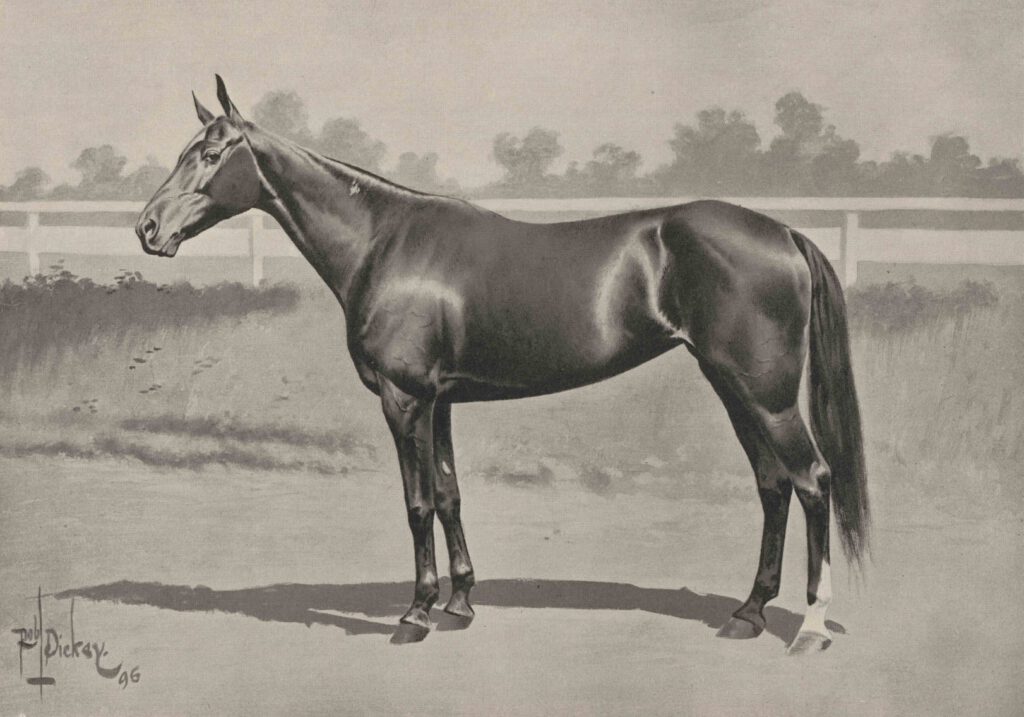
Mambrino Chief’s long-term impact on the standardbred is mostly through his daughters. He is found in the pedigree of many foundations mares: he is the damsire of Jessie Pepper; his son Bay Chief is the paternal grandsire of Minnehaha; his son Mambrino Patchen is the paternal grandsire of Maggie H, Mambrino Beauty (the grandam of Nervolo Belle) and Topsey (the dam of Medio). Mambrino Chief is also found in the pedigree of Mamie and twice in the pedigree of Santos (the dam of Peter the Great). He is also found three times in the pedigree of Axworthy, as well as twice in Bingen, McKinney and Peter the Great. Mambrino Chief’s daughters particularly crossed well with George Wilkes, who moved to Kentucky in the late 1870s.
That said, Mambrino Chief produced many influential sons at stud. One, Woodford Mambrino, also excelled as a trotter. The latter was also very successful in his limited stallion service. The only trotter from Mambrino Chief’s sireline to hold the absolute world record was Alix 2:03 3/4, a paternal great-granddaughter of Woodford Mambrino. Mambrino Patchen was the most famous son of Mambrino Chief, him standing stud at Dr Herr’s Forest Park in Kentucky for many years. Mambrino Patchen was the sire of the famous Mambrino King, described as the handsomest horse in the world and also a good sire. Another son of Mambrino Chief was Mambrino Pilot, sire of Mambrino Gift, the first stallion to trot in 2:20, as well as Aemulus, the first American-owned trotter to compete at Vincennes. Though his sireline didn’t survive for too many generations, Mambrino Chief was undoubtedly a massively important stallion.
mambrino chief
Bay colt born in Mabbettsville, NY in 1844. Died in Woodford County, KY on Mar 28, 1862.
Mambrino Paymaster – Eldridge Mare (Messenger Duroc?)
unstarted
Breeder: Richard Eldridge
Owners: Richard Eldridge – Warren Williams – GT Williams – James M Cockroft – James B Clay – Willis Jones
Trainers: –
Drivers: –
Grooms: –

